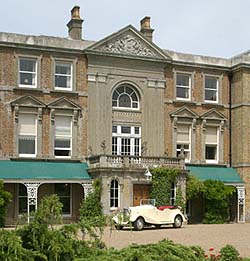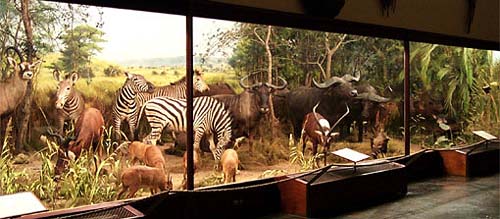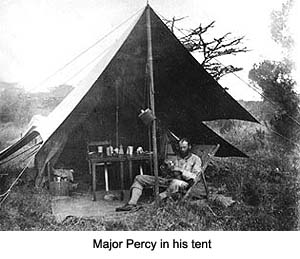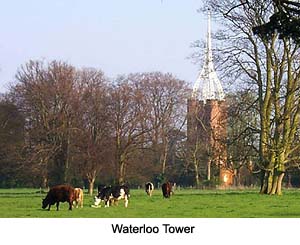Quex House and the Powell-Cotton Museum
by Richard Crowhurst
 Behind the small town of Birchington in Kent lies
Quex House, home of a remarkable museum. Step through the
entrance and you enter a Victorian world filled with a
fascinating collection of zoological and anthropological
artefacts. Behind the small town of Birchington in Kent lies
Quex House, home of a remarkable museum. Step through the
entrance and you enter a Victorian world filled with a
fascinating collection of zoological and anthropological
artefacts.
The first house was built in the early 1400s, the estate passing
through several families before the Powell-Cottons arrived
towards the end of the 18th century. They built a large country
mansion in the Regency style, replacing an earlier timber and
stone building. In 1813 John Powell-Powell inherited the estate
from his elder brother Arthur and rebuilt the mansion, adding a
tower from which to watch ships navigating the north Kent coast.
He also planted many trees and built the Waterloo bell tower.
Several rooms of the house are open to the public during summer
afternoons, including the Oriental Drawing Room, which houses
furniture collected by Major Powell-Cotton. As well as oriental
pieces there are collections of English furniture, clocks,
silverware and paintings. At the rear of the house John
Powell-Powell's collection of cannon can be seen on the Veranda,
and there are 10 acres of beautiful gardens to explore, including
lawns, borders and restored glasshouses.
The Museum
The Museum was established by Major Percy Horace Gordon
Powell-Cotton, who spent forty years exploring Africa and Asia
and collecting in the UK. Once he'd run out of room in the house,
he built a 'Pavilion' alongside. This was opened to family and
friends around 1895, and today it is just one gallery in a museum
that displays around 400 animal specimens. The overall collection
is huge and the curator, Malcolm Harman, admits that the
artefacts never been totalled up. He estimates that the
ethnography section alone contains around 18,000 items.
Arguably the most famous galleries are those housing the
taxidermy. Modern attitudes have, perhaps, distorted the
scientific nature of the collection and although some sections
may not be to everyone's taste, Powell-Cotton was a genuine
conservationist. Many of the animals are displayed in such a
convincing manner that you almost forget you're not on the
African Savannah. As well as the stunning dioramas there are
mounted heads and carefully preserved skins. The glass case
housing a lion in mid-attack on a buffalo is one of my personal
favourites. Irrespective of your moral stance on Percy
Powell-Cotton's hunting exploits, nothing brings home the reality
of the natural world better than this stunning example of the
taxidermist's art.

The collection contains almost every African mammal (there are
over 5,000 additional species behind the scenes), including some
species that casual visitors would be forgiven for never hearing
of, such as Mrs Gray's Lechwe and Hunter's Hartebeest. No animal
in the collection is extinct. On the contrary, many species that
were endangered in Powell-Cotton's time are now thriving as a
result of his educational legacy. The museum is also proud of its
primate collection. Many of these were traded from local people
who routinely hunted the animals for food.
Other galleries display a wide range of African cultural
artefacts, including jewellery, costumes, weapons and domestic
utensils. The exhibition helps to put many of these into context,
with background information and photographs of many of the ethnic
groups that Powell-Cotton met during his travels. The collection
bug was also passed on to two of the Major's daughters, who added
several thousand objects, photographs and films from their own
travels in Angola.
In one of the most exciting and diverse collections in private
ownership, there are also displays of local archaeology, firearms
and cutting weapons from around the world, Asian artefacts,
Japanese Netsuke and porcelain. Many of these items were obtained
by the Major from sale rooms and auctions. Much of the porcelain
came from the collection of Mr Pope, a former Catholic
missionary. Having purchased some of the items at auction, Major
Powell-Cotton arranged to buy the rest privately. They consist of
European and Chinese export pieces and some of the most prized
items are those that were made exclusively for use by the
Imperial Emperor in the Forbidden City. Most of this dates from
the Quing and Minq Dynasties and includes examples of the highly
prized and exclusive 'yellow' porcelain reserved for the
Emperor's immediate family.
The Waterloo Tower
During opening hours visitors can also walk through the private
parkland to the Waterloo tower, which was built in 1819 by John
Powell-Powell. He was a keen bell-ringer and even developed his
own technique named 'Steadman Triples.' For safety reasons it is
not possible to climb the tower, but the Quex Park Society of
Change Ringers still maintains the bells and practices twice a
week. The spire is inspired by a church in the town of Faversham,
but observers say it reminds them of the Eiffel Tower.
Powell-Cotton's Legacy Today
 Modern
sensibilities may have been overly harsh in their judgement of
Major P. H. G. Powell-Cotton, but his legacy is now acknowledged
as being invaluable in helping modern conservationists around the
world. Students and researchers come from around the world.
Recent visitors have included those from Africa, Canada,
Australia, Norway and the USA, as well as closer to home and the
museum regularly works alongside London's Natural History Museum
and the Smithsonian Institute. Modern
sensibilities may have been overly harsh in their judgement of
Major P. H. G. Powell-Cotton, but his legacy is now acknowledged
as being invaluable in helping modern conservationists around the
world. Students and researchers come from around the world.
Recent visitors have included those from Africa, Canada,
Australia, Norway and the USA, as well as closer to home and the
museum regularly works alongside London's Natural History Museum
and the Smithsonian Institute.
DNA from the collection has been used to help save the Giant
Sable, which has been reduced to just 500 animals in its native
Angola. DNA from the collection's Quagga confirmed its
relationship to the more common Cape Mountain Zebra. This has
enabled a breeding programme which, over the years, has produced
two stable populations of Cape Mountain Zebra with an external
appearance that strongly resembles the Quagga.
Major Powell-Cotton was meticulous in his recording and the
collections are backed by detailed maps, diaries, films and
photographs, all of which have provided an invaluable historic
record for environmentalists, anthropologists and conservation
workers.

Getting There
The small town of Birchington is easily reached by car and the
museum is located just under a mile from the town centre. Follow
the signs before the mini-roundabout on the A28 road, opposite
the church. The museum is also close to Kent International
Airport
Opening times vary through the summer and although the museum is
closed to the general public in the winter, groups and
researchers are welcome year-round with an appointment. The house
is only open in the afternoon and a 'garden only' ticket is also
available. There is a quality restaurant and a gift shop. Full
details of opening times can be found on the website. However,
much of the museum's literature is currently being revised and so
it may be advisable to call the museum +44 (0) 1843 842168 before
a visit.
Other attractions in the area include the Spitfire &
Hurricane Memorial and Manston Museum at the nearby
airport, and the coastal towns of Margate,
Broadstairs and Ramsgate.
More Information:
We regret that we no longer have the resources to maintain up-to-date links and/or hours and pricing details for the various sites and attractions listed on this website. For more information about the location(s) listed above, please use your favorite search engine or visit Wikipedia.
Richard Crowhurst is a freelance writer and author based in Lincolshire,
England. He writes on many subjects, including history and heritage topics.
More details can be found on his website, http://www.freelance-writer-and-author.co.uk.
Article © 2006 Richard Crowhurst
Photos © Quex Estate and Powell Cotton Museum.
| 